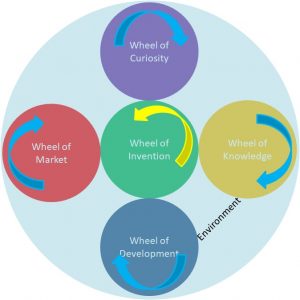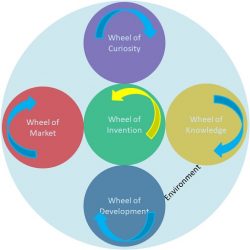Drawing an Analogy
Hello readers, wish you all a very happy new year. I am glad to post the first article in this website that explains the name of the site and forms the base for the subsequent posts. It helps in understanding the relationships among an idea, its development leading to an invention, patenting it and commercialising it; particularly in Indian context.
Let us start with a touchy topic that many people like to talk and debate about – why can India, with a billion population, not win a lot of medals in the Olympic games? We often see a lot of assessments in the media and committees are formed after each games to identify the ways to do better.
I do not intend to discuss the outcomes of these assessments and committees, and rather would like to point towards a success story. While the country as a whole have failed to boost the available talents, a gentleman named Mr. Gopichand (needs no introduction) has successfully created a winning environment for one of the Olympic sports, Badminton. In less than a decade time his academy has produced 2 Olympic medals (7% of India’s total tally of 28 medals in more than 100 years). Moreover he has produced a number of excellent world class players who promise to deliver more exceptional results. By now you might be wondering what Mr. Gopichand’s academy has got to do with this website that claims to concentrate on inventions and patents. Please be with me, we are going there in a moment. All I am trying to highlight is the impact of right mindset and environment on the outcome that Mr. Gopichand has demonstrated.
Analogous to India’s poor record in Olympics we are equally short in producing outstanding inventions. With due respect to all the great minds who have done and are doing their best against all odds, we have never been a force in this arena. That’s why I thought in India inventions are analogous to the Olympic medals – have a huge pool of talent but the number of inventions disappoints. The question is – can we learn from this analogy and replicate Mr. Gopichand’s success for useful inventions in future?
A few months back I read a speech given by Infosys co-founder Mr. Narayanmurthy in front of the IISc graduates. There he pointed out the amount of impact MIT has made on technology and how we in India lack that trend. Surely he had a point. However, such discussions are not uncommon in media and anybody with an unbiased eye towards technological advancements in this country would readily agree to it. Here comes the next question – what can we do to replicate Mr. Gopichand’s model in the field of invention? There may exist multiple ways to do this. In this post I am going to explain an holistic view of what contributes to an invention.
Wheels of Invention – What it MeanS
Let us look at the title of this website. What do I mean by “Wheels of Invention”? Let us imagine the environment as a sphere in which an inventor has to work and many factors inside this sphere affect outcome of the inventor’s efforts. Some of these factors are more influential than others. I like to term these more influential factors as the wheels of invention. These are:
- Wheel of Invention
- Wheel of Curiosity
- Wheel of Knowledge
- Wheel of Development
- Wheel of Market
As seen in the figure below the wheels are interrelated. This interrelation is shown as rotation. As the outer wheels (drivers) are in contact with the central wheel (driven), any variation in these wheels’ rotation will determine how the central wheel of invention will rotate and hence perform. To keep the things simple, to ensure a successful invention, an inventor has to be aware of the wheels and should preferrably be able to control them to some extent. I am now going to briefly explain the wheels. Our subsequent posts in this website will align to these wheels for better understanding.

Wheel of Invention
This is the wheel which actually churns out a successful invention. It is not necessary that a patent has to be obtained for an invention, it is a choice left with the inventor. However, a patent is a formal recognition of the invention and the inventor and therefore is the most important aspect of this wheel.
This is an area that poses a lot of difficult questions in a new inventor’s mind. For example, is my work patentable; how do I patent it; who can help me; would it cost me a lot to get a patent etc. Lack of awareness in this area is common in India, be it for individuals or academics or industry; except maybe for the bigger institutes or industries. Even in premier technical institutes, where patent cells exist to guide the inventors, publishing research papers take priority and often patenting is not considered, although publishing such papers is still possible after applying for a patent. So, the bottom line is that the technical community must have at least basic awareness about patenting if we are to get more patents. A considerable number of future articles in this website will concentrate on creating such awareness.
To summarise, Wheel of Invention emphasises on awareness about patents.
Wheel of Curiosity
In my view everything related to an invention starts here. The product is actually conceived at this stage. Here the inventor identifies an opportunity for something new and embarks on the journey to build upon it. Have you ever tried ironing your shirt on a Monday morning for office and thought “How boring and time consuming process! Why is not there a washing machine like device for automatically ironing the clothes”? That’s an example where an invention may be conceived. I would like to share later a few real examples.
So the important thing for a potential inventor is to keep eyes open and looking for opportunities that can be converted into products and processes. Such opportunities may be identified from various sources like identifying a problem (as in the above example), from a research work, from market demand, simply hitting upon an idea (solution) first and even from historically failed/incomplete technological attempts.
If it’s so simple, then why don’t we see great inventions often in this country? The answer is – no, we in fact see some great inventions here and there, which make ripples for sometime. However, most of them are result of individual brilliance and not due to a system. Those inventors have surely gone through the same process. Unfortunately our academic system does not encourage much to be curious to create enormous opportunities. All is not lost though; there is an excellent initiative by National Innovation Foundation in this area to gather concepts for developing further. I hope they will be able to reach to the grass root level more and more, and will support the talents we have.
To summarise, the Wheel of Curiosity emphasises on identifying new ideas by an individual or system.
Wheel of Knowledge
Here comes the next wheel. Once a problem is identified or an idea is available to solve a specific problem, it needs to be nurtured in a right manner. The inventor is not expected to know everything beforehand, he/she may have to learn many things. I know people who have some ideas but due to lack of right information they struggle to progress further. Access to relevant sources of knowledge is the key here. The sources include, but not limited to – libraries, research databases, teachers, industry professionals, other inventors etc. Such sources are not easily accessible to many people in India and it hampers our prospect in the field of invention.
To summarise, the Wheel of Knowledge emphasises on getting relevant information/knowledge from the right sources at the right time.
Wheel of Development
This one is perhaps a tricky one. You have a great idea and knowledge but still converting it to a finished product may be extremely challenging. Apart from people who are actually involved in design and development, other people may not be able to appreciate the minute things that go into development. For example, I can design a mechanical part in great detail which may eventually become a manufacturing nightmare and may eventually send me back to square one. The key here is excellent planning before jumping into the actual work and relying on team work. While the previous two wheels may be managed well individually, this one may not be. It often requires expertise of various people to develop a real product.
To summarise, the Wheel of Development emphasises on developing your idea through proper planning and team work.
Wheel of Market
This is even a trickier one. Let us burst a myth here. Many people think that getting a patent is end of the story, after which everything is just “they lived happily thereafter”. There will be automatic fame and fortune following the invention. If it happens that’s great but unfortunately, it does not happen most of the time. Not all the patented products see light of the market in reality. There is no doubt that even an uncommercialised invention also contributes to the future technology but getting it commercialised is the most desirable outcome. Without getting their products in market, the great Mr. Edison or Tesla would not have been that great.
Unfortunately, there is no easy and defined way to successfully market a product, particularly in India where such environment does not exist. However, there are recent initiatives to support inventors making it to the market. I would discuss this in later articles.
To summarise, the Wheel of Market emphasises on commericalisation on an invention.
Summary
An invention is an outcome of four influential factors, imagined as four driving wheels. Any inventor has to have some awareness and control over these wheels to be successful. That is all for today. We will be back with more informative articles in the coming days.
About the author: The author is an experienced Mechanical Engineer and inventor.

